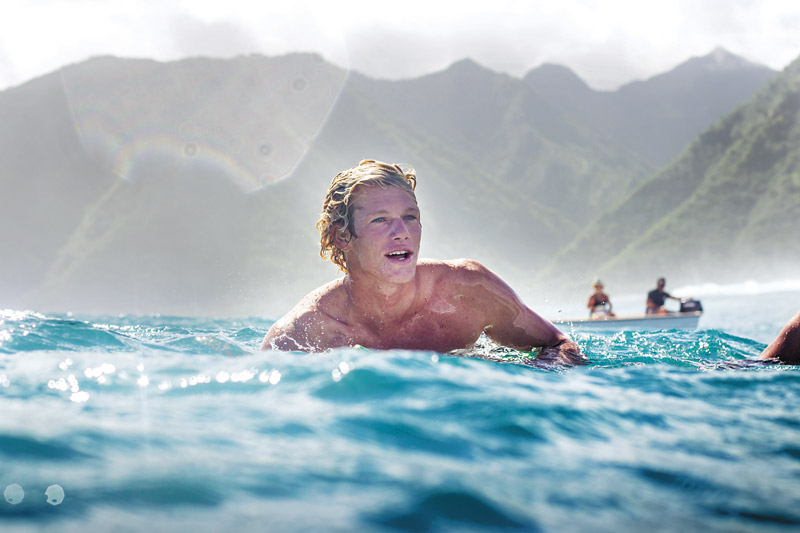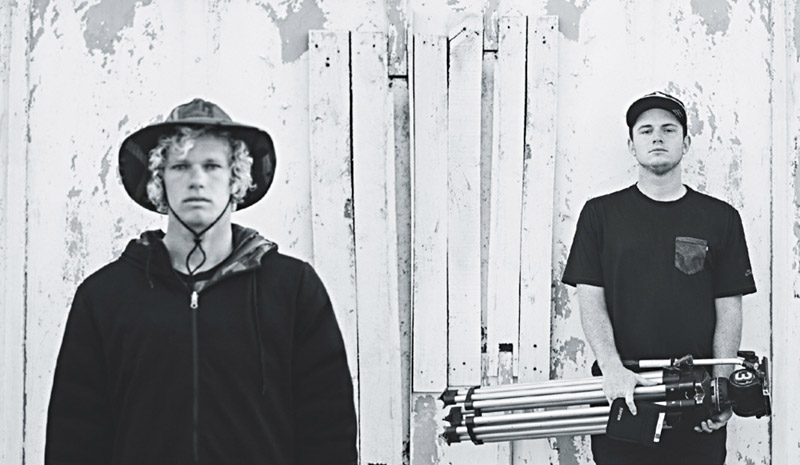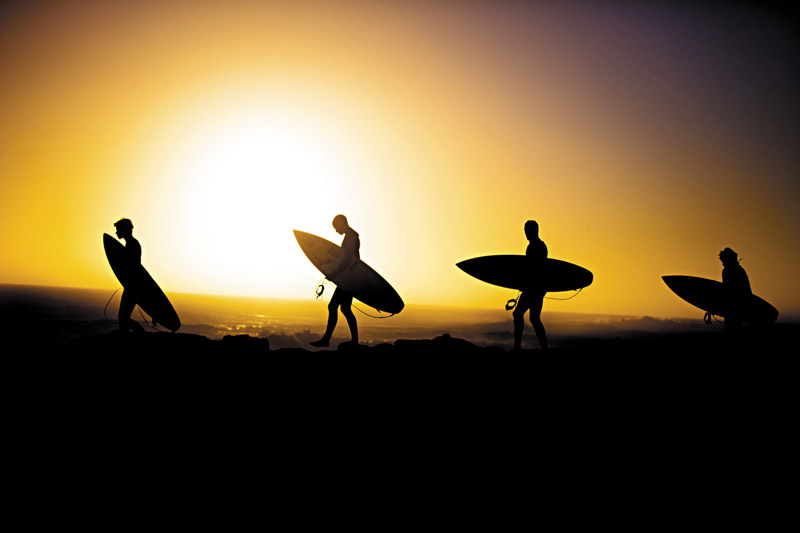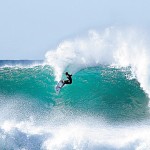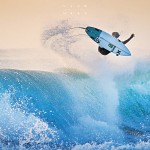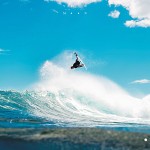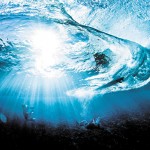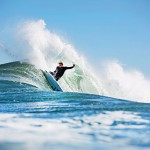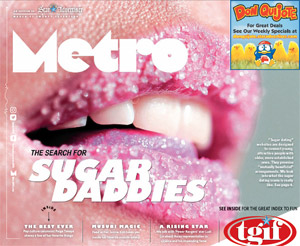A New View
When filmmaker Blake Vincent Kueny met professional surfer John “John” Florence while he was working a surf trip in the Maldives, they bonded over a lot of things — their mutual love for surfing and skateboarding, for photography and filmmaking, and being the youngest guys on the trip. Somewhere during those early conversations, they threw out an idea that must have seemed like a pipe dream to a couple of 20-year-olds: to push the limits of what is possible in a surf film.
After three years of filming and traveling, the duo did it: At the end of 2015, they released their View From A Blue Moon, a surf epic that follows Florence and friends through waves in Australia, Brazil, Africa, and, of course, Florence’s native North Shore. The film combines Florence’s particular breed of acrobatic-like surfing with sweeping landscape imagery and has some big-name support: a cadre of professional surfers, a collaboration with Brain Farm film studio and narration by John C. Reilly. Numerous reviews have praised it as the best surf film ever made.
View From A Blue Moon kicks off the annual month-long Honolulu Surf Film Festival at Honolulu Museum of Art, with an opening-night reception at 6 p.m. July 2, followed by the film screening at 7:30.
“We’ve selected it as the opening-night film because it’s one of the best surf films to have come out in a long time,” says Doris Duke Theatre director Taylour Chang. “It combines beautiful imagery with great surfing, a real crowd-pleaser.”
“It’s the perfect film to kick off the month-long celebration of surf,” she adds.
It’s really no wonder that View From A Blue Moon is receiving the praise it has (and the accolades to go along with it — it was voted Movie Of The Year in the 2015 SURFER Magazine Poll Awards). The film is largely a sort of year-in-the-life depiction of Florence, who has long been regarded as the wunderkind of the surfing world. Only 23, Florence already has won multiple competitions, including the Triple Crown, and more recently, The Eddie. Focusing primarily on Florence, View From A Blue Moon is stocked with seemingly gravity-defying maneuvers.
And the camera work, courtesy of Kueny, is just as stunning.
Kueny, 24, has been interested in cameras as far back as he can remember.
It’s something he largely attributes to his home-video-loving grandfather, who he recalls, “would record everything, whatever we did.” Kueny was drawn to that type of documentarian aspect of it — that he could capture a moment in time and have a record of it forever.
“I really like to find a moment, being able to look through a camera and just get lost in the frame and be able to come back with something beautiful — maybe something that someone else wasn’t seeing,” Kueny recalls. “Being able to share what I was seeing and capture that was a thrilling experience.”
By the time he was 15, Kueny had started filming his friends surfing.
“You just go down to the beach when the waves are good, you pull out your camera and see what you got,” Kueny says. “I had that canvas in my backyard, so it was kind of a natural fit.”
He landed an internship in the video production department at Transworld Surf while still in his teens, and before long, he was working with some of the industry’s top surfers. It was during a stint as pro surfer Jordy Smith’s filmmaker that he met Florence. View From A Blue Moon marks the latest in a string of collaborations from the pair, which has included their 2013 film Done, as well as a series of short films.
“That was just such a natural fit that it didn’t feel like he was working, it didn’t feel like I was working,” he says of his partnership with Florence. “It was just two people hanging out, doing what they loved.”
Metro recently got a chance to chat with Kueny about working with Florence, the film and putting it all together.
When you first met John, how did you two initially connect?
I think, honestly, it was just that we were closer in age than anyone else (on the trip), and we had just a very similar kind of outlook. We were at the same point in our lives — we are six months apart — and being that young and just, like, wanting to take over the world. There was this kind of blind ambition to conquer the world and do fun stuff.
For you as a filmmaker, what made you want to work with John?
With surf films, it’s more than my just picking someone to make a film like this with … It really takes him to be just as willing and passionate about making something — because it takes so much effort and dedication on his part. You need to have the camera rolling for hours and hours and hours and see him keep (going) and keep bettering himself. I can’t direct anything like that; that is just something that comes from inside him.
Did you have a favorite filming location?
I really enjoyed South Africa. Everywhere else you go in the world, it seems like it has been discovered. Something about Africa feels like it is a new frontier in a way — I think there are still places that no one has ever been with a surfboard. And you just find these nooks and crannies of the world where it’s like, wow, I don’t think more than 100 people have been in this place.
When you weren’t shooting, did you have time to explore these different locales?
That was kind of the beauty of these trips. They were meant, in a way, for John to go explore places that he wanted to go explore and bring cameras with him. We picked places that we wanted to see.
And then the cool thing for both of us too is that we were learning the filmmaking side. We had made a film before, but we were getting to (use) these helicopters and the highest technology that is available at the time, and it was really cool. We were getting to explore the world and learn.
Other than the imagery and the surfing, one thing I thought was interesting was the way the film was edited. There are what I thought were some unique choices, like toward the end of the film, when John is back home on the North Shore. There is something distinctly unsettling about that sequence. What were you trying to communicate there?
Out of all the places John goes, he still says that home is the most peaceful, and when he is in the water at Pipeline, there is no better place to be in the world. That being said, the North Shore in the wintertime is probably one of the most stressful places for John to be, with the whole surf industry being there. So what we tried to build with that part was when he leaves his home and he is riding down the bike path, there is so much chaos on the North Shore — people are getting rescued, just all sorts of things … It’s supposed to show the viewer that when he gets to the water with his friends, that is when it all becomes peaceful.
View From A Blue Moon is being called the best surf film ever made. How does that feel?
It feels good, you know. I think this is the first time I’ve actually talked about it since it was in the heat of the moment just finishing it and getting it out there, and I didn’t know how to feel about it. And now that the dust has settled and people are still loving it, it’s insane. I think more so than anything, it’s just an honor for the people of Hawaii to embrace it and love it as much as they do. For that to happen and to have the broad appeal across the Internet, across America and across the world is unbelievable. And to think it started with John and I together just talking about how we wanted to make something … This is beyond expectations.
For more information and to purchase View From A Blue Moon, visit viewfromabluemoon.com. In addition to its opening-night screening, View From A Blue Moon also will be shown at the Honolulu Surf Film Festival 4 p.m. July 10 and 17 and 1 p.m. July 28. Other films screened throughout the festival include Psychic Migrations, Fire and Water and Shorebreak: The Clark Little Story. The museum hosts a closing reception from 6 to 7:30 p.m. July 31, followed by a screening of feature film Surfing the Fifties. For the full Honolulu Surf Film Festival lineup, visit honolulumuseum.org.

